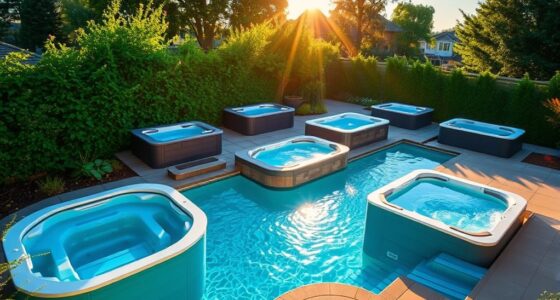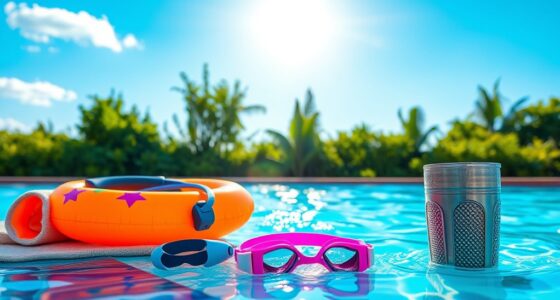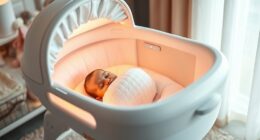If your swim spa’s water isn’t balanced, start by regularly testing pH, alkalinity, and sanitizer levels at least twice weekly. Adjust pH to stay between 7.2 and 7.8, and keep alkalinity stable to prevent pH swings. Make sure sanitizer levels stay effective without causing irritation. If you notice cloudy water, skin issues, or equipment problems, these are signs of imbalance. Stay tuned to discover more tips on troubleshooting and maintaining perfect water chemistry.
Key Takeaways
- Regularly test water chemistry (pH, alkalinity, sanitizer levels) at least twice weekly to identify imbalances early.
- Adjust pH to stay within 7.2–7.8, using proper chemicals and following manufacturer instructions.
- Maintain appropriate sanitizer levels to prevent bacteria growth and skin irritation, adding shock treatments as needed.
- Manage alkalinity carefully to stabilize pH and prevent swings, making gradual adjustments with the right products.
- Address water imbalances promptly to prevent cloudiness, corrosion, and equipment damage, ensuring safe and clear swim spa water.

Are you struggling to maintain the right water balance in your system? If so, you’re not alone. Many swim spa owners face challenges keeping the water properly balanced, especially when it comes to pH adjustment and sanitizer levels. Proper water balance isn’t just about comfort; it’s vital for preventing damage to your equipment and ensuring safe, clean water. When your water’s pH is off, it can lead to cloudy water, skin irritation, and even corrosion of your spa components. Likewise, if sanitizer levels aren’t correctly maintained, bacteria and algae can thrive, making the water unsafe and uninviting.
Maintaining proper water balance is essential for a safe, clear, and well-functioning swim spa.
The first step in troubleshooting water balance issues is regularly testing your water. Use reliable test kits or digital testers to check the pH, alkalinity, and sanitizer levels at least twice a week. When you notice your pH is too high or too low, it’s time for adjustments. pH adjustment involves adding specialized chemicals—either pH increasers or decreasers—based on your test results. Keeping the pH within the recommended range of 7.2 to 7.8 ensures your sanitizer works effectively and prevents scaling or corrosion. If your pH is too high, adding a pH reducer will lower it; if it’s too low, a pH increaser will bring it back into balance. Always follow the manufacturer’s instructions carefully to avoid overcorrecting, which can cause further issues.
Maintaining proper sanitizer levels is equally important. Chlorine or bromine are common sanitizers used to kill germs and bacteria. If your sanitizer levels are too low, bacteria can proliferate, leading to cloudy, smelly water. Conversely, overly high sanitizer levels can cause skin and eye irritation and may damage your spa’s surfaces. Regularly test your sanitizer levels and add the appropriate amount of sanitizer as needed. Remember, shock treatments can also help restore sanitizer levels after heavy use or contamination.
Additionally, monitor your total alkalinity, which acts as a buffer for pH stability. If alkalinity is too low, pH swings become more frequent; if it’s too high, it can cause pH to drift upward. Adjust alkalinity gradually using products designed for this purpose, and always retest after each adjustment. Keeping these parameters in harmony creates a stable environment for your swim spa, reducing the frequency of troubleshooting and chemical adjustments. Incorporating water testing with reliable kits helps you maintain consistent water quality and extend the lifespan of your equipment.
Frequently Asked Questions
How Often Should I Test My Swim Spa Water?
You should test your swim spa water at least two to three times a week to maintain proper chemical balance. Regular testing allows you to make timely chemical adjustments, ensuring water stays clean and safe. If you notice heavy use or after chemical additions, test more frequently. Consistent testing frequency helps prevent issues like algae growth or corrosion, keeping your swim spa inviting and well-maintained.
What Products Are Safest for Water Balancing?
You should choose products that are specifically designed for swim spas, ensuring chemical compatibility with your system. Opt for balanced chemicals that maintain mineral balance and prevent corrosion or scaling. Look for trusted brands that provide clear instructions and test your water regularly to confirm the products work effectively. Avoid harsh chemicals that could disrupt your water chemistry, and always follow the recommended dosage for safe, effective water balancing.
Can Water Balance Issues Cause Equipment Damage?
Think of your swim spa’s water as a delicate dance—poor balance can lead to water corrosion and equipment failure. When pH, alkalinity, or sanitizer levels are off, it accelerates corrosion of metal parts and damages your equipment. Ignoring water balance issues is like ignoring a ticking time bomb; it risks costly repairs and replacements. Keep your water balanced, and you’ll prevent equipment damage, ensuring your swim spa stays in top shape.
How Do I Adjust Chemicals for Temperature Changes?
When temperature effects change, you need to make chemical adjustments to maintain proper water balance. First, test your pH and alkalinity levels regularly. If the water gets warmer, increase chlorine or sanitizer levels to prevent bacteria growth. Cold temperatures may require you to add more chemicals to keep pH stable. Always follow manufacturer instructions for chemical adjustments, and retest after making changes to guarantee your swim spa stays balanced and safe.
What Are Signs of Persistent Water Imbalance?
Did you know that over 60% of swim spa owners experience persistent water imbalance? Signs include cloudy water, strong odors, and frequent chemical adjustments. You might also notice mineral buildup around jets or surfaces. These issues indicate your water chemistry isn’t stable, risking equipment damage and health concerns. Regular testing and balancing chemicals help prevent ongoing problems, ensuring clear, safe water and protecting your investment in your swim spa.
Conclusion
Maintaining proper water balance in your swim spa keeps it running smoothly and guarantees a safe, enjoyable experience. Regular testing and adjustments prevent issues before they start, saving you time and money. Are you ready to take control of your swim spa’s water health? With a little effort and attention, you’ll enjoy crystal-clear water and peak performance whenever you plunge in. After all, isn’t a well-balanced swim spa worth the effort?









